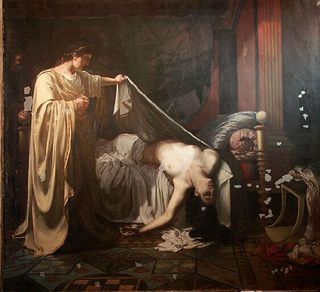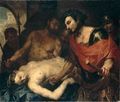Howler averted

It's a good principle not to build any argument on a work of art you havent seen. That's for the obvious reason that when you actually look a painting, or a sculpture, or an object you find out something crucial about it that you won't have spotted from a photograph; nine times out of ten. Sometimes it's as simple as a matter of size. I know that good books will note the dimensions of a painting... but even so it is hard to take in until you see it. It took me years to understand that many of Alma Tadema's nudes were not great big pin-up but small scale things (for the study rather than the hall).
Anyway, that's the principle but it isnt always possible in practice.
This week, I've been preparing my fourth Mellon lecture, on representations of the female members of the Roman imperial court, and I have found myself focussing on the Agrippinas.One of the scenes I have been collecting is a favourite of later painters -- Nero inspecting the body of the dead Agrippina.
And thanks to the wonderful French database, Joconde, I came across the painting at the top of this post ... a great 19th century view by Eugene Appert (no I hadnt heard of him either).
 It is rather more tender than some of the seventeenth century images that I had collected (like the Zanchi here), and I found myself intrigued by the little bits of white paper drifting across the scene.
It is rather more tender than some of the seventeenth century images that I had collected (like the Zanchi here), and I found myself intrigued by the little bits of white paper drifting across the scene.
What was this a reference to. A torn up letter between mother and son? Again there seemed to be a romantic tenderness about that idea. But where had Appert got it from? There was no mention of that in any ancient source I knew. But then there was no mention of Nero dissecting his mother's corpse either... and that is what the Middle Ages go big on.
I was beginning to get very interested.
It wasnt until I tried it out on the big screen that I realised (what you may have guessed already) that it wasn't a torn up letter at all...but some fault on the digi image.
Phew.. at least I hadnt built it into the argument of the lecture. A lucky escape, but a very nice illustration of the basic Beard principle.
Mary Beard's Blog
- Mary Beard's profile
- 4112 followers



